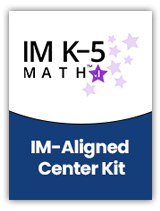Search Listing Name
product:
Project M3: Level 4-5: The Tenth Street Pet Sanctuary: Understanding and Using Decimals Student Mathematician's Journal 1 Year License
The Student Mathematician’s Journal allows students to explore simulated or real-life problems and help them to think, write, and read like mathematicians. It encourages students to reflect on what they have learned in each lesson, think deeply about mathematics, and communicate in writing on worksheets.
This unit provides an introduction to the decimal numeration system, focusing on conceptual unde


product:
IM: Grade 3 Bundle Center Kit
To help educators save time, IM-aligned center kits provide all the printed resources to improve teaching efficiency and enhance student learning!
The Grade 3 Bundle Center Kit includes pre-cut game boards, recording sheets, and center & lessons card decks.
For a detailed list, please Learn more
product:
OpenSciEd Unit 6.6: Cells & Systems Student Edition
OpenSciEd Middle School science program addresses all middle school NGSS standards. This comprehensive science curriculum empowers students to question, design, investigate, and solve the world around them.
- Phenomenon Based - Centered around exploring phenomena or solving problems
- Driven by Student Questions - Storyline based on students’ questions and ideas
- Grounded in Evidence - Incremental building and revision of ideas based on evidence
- Collaborative - class and teacher figure
product:
Animal Populations: A Study Of Physical, Conceptual, and Mathematical Models
This curriculum unit for grades 6-8 integrates population biology and mathematics. The ill-structured problem puts students in the stakeholder role of assistant to the mayor of a small town in which residents are demanding that something be done about the deer that are eating their landscaped plants. Throughout the unit, students deal with physical models, conceptual models, and mathematical models as they tackle the deer problem and the complication of Lyme Disease.
This
product:
Improving Writing K-8: Strategies, Assessments, Resources
Improving Writing: Resources, Strategies, and Assessments, by well-known and trusted authors Susan Davis Lenski and Jerry L. Johns, provides teachers with all the background they need to help students improve their writing skills.
A variety of strategies, assessment ideas, and resources will meet diverse student needs. A quick reference guide helps educators choose a goal and identify possible strategies to teach. Each goal gives background information, multiple instructional s
product:
No Quick Fix: Exploring Human Body Systems
No Quick Fix uses systems as the fundamental concept to help students in grades 6-8 understand cell and tuberculosis biology. In a series of widening concentric circles, students learn that cells are elements in larger systems, such as the immune system and the even larger system of the human body. Students also interact with the human social systems: health care and public education. They will take on the role of physician and begin to search for the cause and resolution of the problem. While unraveling the interacti
